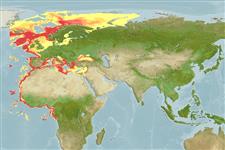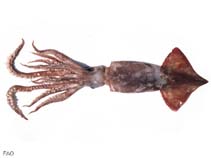Todarodes sagittatus (Lamarck, 1798)
European flying squid| Native range | All suitable habitat | Point map | Year 2050 |

|
| This map was computer-generated and has not yet been reviewed. |
| Todarodes sagittatus AquaMaps Data sources: GBIF OBIS |
Classification / Names Κοινά ονόματα | Συνώνυμα | CoL | ITIS | WoRMS
Cephalopoda | Oegopsida | Ommastrephidae | Todarodinae
Environment: milieu / climate zone / εύρος βάθους / distribution range Οικολογία
βενθοπελαγικό; εύρος βάθους 20 - 4595 m (Αναφ. 81305). Tropical, preferred 20°C (Αναφ. 107945); 85°N - 6°S, 26°W - 158°E (Αναφ. 112293)
Distribution Χώρες | Περιοχές FAO | Οικοσυστήματα | Παρουσίες | Εισαγωγές
Northeast Atlantic, Mediterranean and the Arctic: Congo Dem Rep to Gibraltar, Mediterranean, Spain to Iceland, to Russian Arctic up to Sakha Republic.
Length at first maturity / Μέγεθος / Weight / Age
Γεννητική Ωρίμανση: Lm 23.2, range 20 - ? cm Max length : 75.0 cm ML αρσενικό/απροσδιόριστο; (Αναφ. 3722); μεγ. δημοσιευμένο βάρος: 2.2 kg (Αναφ. 120431); μεγ. αναφερόμενη ηλικία: 2.00 έτη (Αναφ. 120431)
Life cycle and mating behavior Γεννητική Ωρίμανση | Αναπαραγωγή | Γεννοβολία | Eggs | Γονιμότητα | Larvae
Main reference
Αναφορές | Συντονιστής | Συνεργάτες
Schneider, W. 1990 FAO species identification sheets for fishery purposes. Field guide to the commercial marine resources of the Gulf of Guinea. Prepared and published with the support of the FAO Regional Office for Africa. Rome: FAO. 268 p. (Αναφ. 417)
IUCN Red List Status
(Αναφ. 130435: Version 2025-1)
CITES status (Αναφ. 108899)
CMS (Αναφ. 116361)
Threat to humans
Human uses
αλιεία: Εμπορικό(ά)
FAO - αλιεία: landings | FIRMS (Stock assessments) | FishSource | Η θάλασσα γύρω μας
Εργαλεία
Περισσότερες πληροφορίες
Διαδικτυακές πηγές
BHL | BOLD Systems | CISTI | DiscoverLife | FAO(αλιεία: ; publication : search) | Fishipedia | GenBank (genome, nucleotide) | GloBI | Gomexsi | Google Books | Google Scholar | Google | PubMed | Δέντρο Ζωής | Wikipedia (Go, αναζήτηση) | Zoological Record



